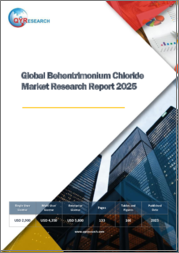
|
시장보고서
상품코드
1572294
세계의 염화벤질 시장 : 부문별 예측(2025-2030년)Benzyl Chloride Market by Application (Benzoic Acid, Benzyl Alcohol, Chemical Intermediates), End-Use Industry (Chemical Industry, Paints And Coatings, Pharmaceuticals), Function - Global Forecast 2025-2030 |
||||||
염화벤질(Benzyl Chloride) 시장은 2023년에 4억 4,834만 달러로 평가되었고, 2024년에는 4억 6,978만 달러에 이를 것으로 추정되며, CAGR 4.18%로 성장하며, 2030년에는 5억 9,729만 달러에 달한다 그렇다고 예측됩니다.
염화벤질은 다양한 화학물질을 합성할 때 중간체로서 중요한 유기 화합물입니다. 그 범위는 의약품, 농약, 염료, 플라스틱 등 다방면에 걸쳐, 벤질알코올, 시안화벤질, 아크릴산벤질 등 화합물을 제조하는 전구체로서 기능합니다. 염화벤질의 필요성은 그 유도체인 페닐아세트산이 중요한 역할을 하는 필수 의약품이나 농약의 제조에 대한 응용에 기인하고 있습니다. 염화벤질을 널리 사용하는 최종 용도 산업에는 개인 관리, 식품 및 섬유가 포함되며 코팅 및 페인트의 유용성은 말할 필요도 없습니다. 염화벤질 시장은 효과적인 약제와 강화된 작물 보호 솔루션에 대한 요구가 증가함에 따라 의약품 및 농약에 대한 수요 증가의 영향을 크게 받고 있습니다. 게다가 산업용 응용 분야에서 고성능 화학물질을 이용하는 경향이 높아지고 있는 것도 시장의 성장을 더욱 뒷받침하고 있습니다. 그러나 염화벤질의 생산과 사용과 관련된 환경 문제와 엄격한 규제는 취급에 대한 위험과 함께 한계를 초래하고 안전 대책과 규정 준수 개선이 필요합니다. 잠재적인 기회는 지속가능성 목표에 부합하는 친환경 생산 기술 개발에 있습니다. 친환경 화학물질의 원칙을 도입함으로써 경쟁력을 높이고 규제 문제를 해결할 수 있습니다. 혁신의 측면에서 환경에 미치는 영향을 최소화하는 대체 전구체 및 촉매 시스템의 연구가 진전을 촉진할 수 있습니다. 시장 경쟁은 중간 정도이며, 새로운 용도를 발견하기 위해 연구 개발에 투자하고 있는 기존 기업이 많은 것이 특징입니다. 시장의 잠재력을 활용하기 위해 기업은 비용 효율적인 생산 공정를 가능하게 하는 기술적 진보에 초점을 맞추고 제품 라인을 강화하기 위한 전략적 파트너십을 모색해야 합니다. 시장 분석 및 고객 피드백에 디지털 솔루션을 활용하여 공급망 효율성을 개선하고 시장 도달범위를 확대할 수 있습니다.
| 주요 시장 통계 | |
|---|---|
| 기준연도(2023년) | 4억 4,834만 달러 |
| 추정연도(2024년) | 4억 6,978만 달러 |
| 예측연도(2030년) | 5억 9,729만 달러 |
| CAGR(%) | 4.18% |
시장 역학 : 빠르게 진화하는 염화벤질 시장의 주요 인사이트
염화벤질 시장은 수요 및 공급의 역동적인 상호 작용에 의해 변모하고 있습니다. 이러한 시장 역학의 진화를 이해함으로써 기업은 충분한 정보를 바탕으로 투자결정, 전략적 결정 정밀화, 새로운 비즈니스 기회 획득에 대비할 수 있습니다. 이러한 동향을 종합적으로 파악함으로써 기업은 정치적, 지리적, 기술적, 사회적, 경제적 영역에 걸친 다양한 리스크를 경감할 수 있을 뿐만 아니라, 소비자 행동과 그것이 제조 비용 또는 구매 동향에 미치는 영향을 보다 명확하게 이해할 수 있습니다.
- 시장 성장 촉진요인
- 폴리머 안정제의 합성에서 염화벤질의 이용 확대가 수요를 촉진
- 일렉트로닉스 산업의 확대에 의한 원료로서 염화벤질의 요구 증가
- 염화벤질을 이용한 안전하고 효과적인 살균제에 대한 소비자의 기호의 고조
- 시장 성장 억제요인
- 고순도 염화벤질의 가용성 제한
- 시장 기회
- 퍼스널케어 및 화장품에 염화벤질의 채택 증가
- 특수 화학제품이나 첨단 재료에서 염화벤질 용도의 확대
- 섬유산업에서 염화벤질의 혁신적 애플리케이션 개발
- 시장 과제
- 염화벤질 합성의 복잡성에 의한 비용 효율적인 생산 기술의 개발
Porter's Five Forces : 염화벤질 시장을 탐색하는 전략 도구
Porter's Five Forces 프레임워크는 염화벤질 시장 경쟁 구도를 이해하는 중요한 도구입니다. Porter's Five Forces 프레임워크는 기업의 경쟁력을 평가하고 전략적 기회를 탐구하는 명확한 기술을 제공합니다. 이 프레임워크는 기업이 시장 내 세력도를 평가하고 신규 사업의 수익성을 판단하는 데 도움이 됩니다. 이러한 통찰을 통해 기업은 자사의 강점을 활용하고, 약점을 해결하고, 잠재적인 과제를 피할 수 있으며, 보다 탄력적인 시장 포지셔닝을 보장할 수 있습니다.
PESTLE 분석 : 염화벤질 시장에서 외부 영향을 파악
외부 거시 환경 요인은 염화벤질 시장의 성과 역학을 형성하는데 매우 중요한 역할을 합니다. 정치적, 경제적, 사회적, 기술적, 법적, 환경적 요인 분석은 이러한 영향을 탐색하는 데 필요한 정보를 제공합니다. PESTLE 요인을 조사함으로써 기업은 잠재적인 위험과 기회를 더 잘 이해할 수 있습니다. 이 분석을 통해 기업은 규제, 소비자 선호, 경제 동향의 변화를 예측하고 앞으로 예상되는 적극적인 의사 결정을 할 준비를 할 수 있습니다.
시장 점유율 분석 : 염화벤질 시장 경쟁 구도 파악
염화벤질 시장의 상세한 시장 점유율 분석을 통해 공급업체의 성과를 종합적으로 평가할 수 있습니다. 기업은 수익, 고객 기반, 성장률 등 주요 지표를 비교하여 경쟁 포지셔닝을 밝힐 수 있습니다. 이 분석을 통해 시장 집중, 단편화, 통합 동향을 밝혀내고 벤더들은 경쟁이 치열해지는 가운데 자사의 지위를 높이는 전략적 의사 결정을 내리는 데 필요한 지식을 얻을 수 있습니다.
FPNV 포지셔닝 매트릭스 : 염화 벤질 시장에서 공급업체의 성과 평가
FPNV 포지셔닝 매트릭스는 염화벤질 시장에서 벤더를 평가하는 중요한 도구입니다. 이 행렬을 통해 비즈니스 조직은 공급업체의 비즈니스 전략과 제품 만족도를 기준으로 평가하여 목표에 맞는 충분한 정보를 바탕으로 의사 결정을 내릴 수 있습니다. 네 가지 사분면을 통해 공급업체를 명확하고 정확하게 세분화하여 전략 목표에 가장 적합한 파트너 및 솔루션을 파악할 수 있습니다.
전략 분석 및 추천 : 염화벤질 시장에서 성공으로 가는 길 찾기
염화벤질 시장의 전략 분석은 세계 시장에서 존재를 강화하려는 기업에 필수적입니다. 주요 자원, 능력 및 성과 지표를 검토함으로써 기업은 성장 기회를 파악하고 개선을 위해 노력할 수 있습니다. 이러한 접근 방식을 통해 경쟁 구도에서 과제를 극복하고 새로운 비즈니스 기회를 활용하여 장기적인 성공을 거둘 수 있는 체제를 구축할 수 있습니다.
이 보고서는 주요 관심 분야를 포괄하는 시장의 종합적인 분석을 제공합니다.
1. 시장 침투 : 현재 시장 환경의 상세한 검토, 주요 기업의 광범위한 데이터, 시장 도달범위 및 전반적인 영향력 평가를 제공합니다.
2. 시장 개척도 : 신흥 시장의 성장 기회를 파악하고 기존 분야의 확장 가능성을 평가하며 미래 성장을 위한 전략적 로드맵을 제공합니다.
3. 시장 다양화 : 최근 제품 출시, 미개척 지역, 산업의 주요 진보, 시장을 형성하는 전략적 투자를 분석합니다.
4. 경쟁 평가 및 정보 : 경쟁 구도를 철저히 분석하여 시장 점유율, 사업 전략, 제품 포트폴리오, 인증, 규제 당국 승인, 특허 동향, 주요 기업의 기술 진보 등을 검증합니다.
5. 제품 개발 및 혁신 : 향후 시장 성장을 가속할 것으로 예상되는 최첨단 기술, R&D 활동, 제품 혁신을 강조합니다.
또한 이해관계자가 충분한 정보를 얻고 의사결정을 할 수 있도록 중요한 질문에 대답하고 있습니다.
1. 현재 시장 규모와 향후 성장 예측은?
2. 최고의 투자 기회를 제공하는 제품, 부문 및 지역은?
3. 시장을 형성하는 주요 기술 동향과 규제의 영향은?
4. 주요 벤더의 시장 점유율과 경쟁 포지션은?
5. 벤더 시장 진입·철수 전략의 원동력이 되는 수익원과 전략적 기회는?
목차
제1장 서문
제2장 조사 방법
제3장 주요 요약
제4장 시장 개요
제5장 시장 인사이트
- 시장 역학
- 성장 촉진요인
- 폴리머 안정제의 합성에서 염화벤질의 이용 증가에 의해 수요가 증가
- 일렉트로닉스 산업의 확대에 의해 원재료로서 염화벤질 수요가 증가
- 염화벤질을 사용한 안전하고 효과적인 소독제에 대한 소비자의 선호도 증가
- 억제요인
- 고순도 염화벤질의 입수가 한정적
- 기회
- 퍼스널케어 제품 및 화장품의 처방에서 염화벤질의 채택 증가
- 특수 화학제품 및 첨단 재료에서 염화벤질 용도의 확대
- 섬유 산업에서 염화벤질의 혁신적인 응용의 개발
- 과제
- 염화벤질 합성의 복잡성에 의한 비용 효율적인 생산 기술의 개발
- 성장 촉진요인
- 시장 세분화 분석
- Porter's Five Forces 분석
- PESTLE 분석
- 정치적
- 경제적
- 사회적
- 기술적
- 법적
- 환경적
제6장 염화벤질 시장 : 용도별
- 벤조산
- 벤질알코올
- 화학 중간체
- 염료 중간체
- 의약품 중간체
- 계면활성제
제7장 염화벤질 시장 : 최종 용도 산업별
- 화학산업
- 페인트 및 코팅
- 의약품
- 섬유산업
제8장 염화벤질 시장 : 기능별
- 중간체
- 가소제
- 시약
- 용매
제9장 아메리카의 염화벤질 시장
- 아르헨티나
- 브라질
- 캐나다
- 멕시코
- 미국
제10장 아시아 태평양의 염화벤질 시장
- 호주
- 중국
- 인도
- 인도네시아
- 일본
- 말레이시아
- 필리핀
- 싱가포르
- 한국
- 대만
- 태국
- 베트남
제11장 유럽·중동 및 아프리카의 염화벤질 시장
- 덴마크
- 이집트
- 핀란드
- 프랑스
- 독일
- 이스라엘
- 이탈리아
- 네덜란드
- 나이지리아
- 노르웨이
- 폴란드
- 카타르
- 러시아
- 사우디아라비아
- 남아프리카공화국
- 스페인
- 스웨덴
- 스위스
- 터키
- 아랍에미리트(UAE)
- 영국
제12장 경쟁 구도
- 시장 점유율 분석(2023년)
- FPNV 포지셔닝 매트릭스(2023년)
- 경쟁 시나리오 분석
- 전략 분석 및 제안
The Benzyl Chloride Market was valued at USD 448.34 million in 2023, expected to reach USD 469.78 million in 2024, and is projected to grow at a CAGR of 4.18%, to USD 597.29 million by 2030.
Benzyl Chloride is an organic compound crucial as an intermediate in the synthesis of various chemicals. Its scope covers diverse industries such as pharmaceuticals, agrochemicals, dyes, and plastics, where it functions as a precursor to producing compounds like benzyl alcohol, benzyl cyanide, and benzyl acrylate. The necessity for benzyl chloride arises from its application in manufacturing essential pharmaceutical drugs and agrochemicals, wherein its derivative, phenylacetic acid, plays a key role. The end-use industries that extensively use benzyl chloride include personal care, food and beverages, and textiles, not to mention its utility in coatings and paints. The market for benzyl chloride is significantly influenced by the increased demand in pharmaceuticals and agrochemicals, driven by the growing need for effective drugs and enhanced crop protection solutions. Additionally, the rising trend towards utilizing high-performance chemicals in industrial applications further pushes market growth. However, environmental concerns and stringent regulations regarding the production and use of benzyl chloride pose limitations, coupled with hazards related to its handling, which require improved safety measures and compliance. A potential opportunity lies in the development of eco-friendly production techniques to align with sustainability goals. Embracing green chemistry principles can provide a competitive edge and address regulatory challenges. Innovation-wise, research on alternative precursors or catalytic systems that minimize environmental impact could facilitate progress. The market is moderately competitive, characterized by established players investing in R&D to discover new applications. To capitalize on the market potential, companies should focus on technological advancements that enable cost-effective production processes and explore strategic partnerships to enhance their product line. Leveraging digital solutions for market analytics and customer feedback could improve supply chain efficiencies and expand market reach, thereby supporting strategic positioning in this evolving landscape.
| KEY MARKET STATISTICS | |
|---|---|
| Base Year [2023] | USD 448.34 million |
| Estimated Year [2024] | USD 469.78 million |
| Forecast Year [2030] | USD 597.29 million |
| CAGR (%) | 4.18% |
Market Dynamics: Unveiling Key Market Insights in the Rapidly Evolving Benzyl Chloride Market
The Benzyl Chloride Market is undergoing transformative changes driven by a dynamic interplay of supply and demand factors. Understanding these evolving market dynamics prepares business organizations to make informed investment decisions, refine strategic decisions, and seize new opportunities. By gaining a comprehensive view of these trends, business organizations can mitigate various risks across political, geographic, technical, social, and economic domains while also gaining a clearer understanding of consumer behavior and its impact on manufacturing costs and purchasing trends.
- Market Drivers
- Growing utilization of benzyl chloride in the synthesis of polymer stabilizers boosts demand
- Expansion in the electronics industry increases the need for benzyl chloride as a raw material
- Rising consumer preference for safe and effective disinfectants utilizing benzyl chloride
- Market Restraints
- Limited availability of high-purity benzyl chloride
- Market Opportunities
- Rising adoption of benzyl chloride in personal care and cosmetic product formulations
- Expansion of benzyl chloride applications in specialty chemicals and advanced materials
- Development of innovative applications of benzyl chloride in the textile industry
- Market Challenges
- Development of cost-effective production techniques due to complexity in benzyl chloride synthesis
Porter's Five Forces: A Strategic Tool for Navigating the Benzyl Chloride Market
Porter's five forces framework is a critical tool for understanding the competitive landscape of the Benzyl Chloride Market. It offers business organizations with a clear methodology for evaluating their competitive positioning and exploring strategic opportunities. This framework helps businesses assess the power dynamics within the market and determine the profitability of new ventures. With these insights, business organizations can leverage their strengths, address weaknesses, and avoid potential challenges, ensuring a more resilient market positioning.
PESTLE Analysis: Navigating External Influences in the Benzyl Chloride Market
External macro-environmental factors play a pivotal role in shaping the performance dynamics of the Benzyl Chloride Market. Political, Economic, Social, Technological, Legal, and Environmental factors analysis provides the necessary information to navigate these influences. By examining PESTLE factors, businesses can better understand potential risks and opportunities. This analysis enables business organizations to anticipate changes in regulations, consumer preferences, and economic trends, ensuring they are prepared to make proactive, forward-thinking decisions.
Market Share Analysis: Understanding the Competitive Landscape in the Benzyl Chloride Market
A detailed market share analysis in the Benzyl Chloride Market provides a comprehensive assessment of vendors' performance. Companies can identify their competitive positioning by comparing key metrics, including revenue, customer base, and growth rates. This analysis highlights market concentration, fragmentation, and trends in consolidation, offering vendors the insights required to make strategic decisions that enhance their position in an increasingly competitive landscape.
FPNV Positioning Matrix: Evaluating Vendors' Performance in the Benzyl Chloride Market
The Forefront, Pathfinder, Niche, Vital (FPNV) Positioning Matrix is a critical tool for evaluating vendors within the Benzyl Chloride Market. This matrix enables business organizations to make well-informed decisions that align with their goals by assessing vendors based on their business strategy and product satisfaction. The four quadrants provide a clear and precise segmentation of vendors, helping users identify the right partners and solutions that best fit their strategic objectives.
Strategy Analysis & Recommendation: Charting a Path to Success in the Benzyl Chloride Market
A strategic analysis of the Benzyl Chloride Market is essential for businesses looking to strengthen their global market presence. By reviewing key resources, capabilities, and performance indicators, business organizations can identify growth opportunities and work toward improvement. This approach helps businesses navigate challenges in the competitive landscape and ensures they are well-positioned to capitalize on newer opportunities and drive long-term success.
Key Company Profiles
The report delves into recent significant developments in the Benzyl Chloride Market, highlighting leading vendors and their innovative profiles. These include Akzo Nobel N.V., BASF SE, Dow Inc., Eastman Chemical Company, Evonik Industries AG, Formosa Plastics Corporation, INEOS Group, LANXESS AG, LG Chem Ltd., LyondellBasell Industries N.V., Merck KGaA, Mitsubishi Chemical Corporation, PPG Industries, Prakash Chemicals International Pvt. Ltd., Reliance Industries Limited, SABIC, Shin-Etsu Chemical Co., Ltd., Sinopec Limited, Sumitomo Chemical Co., Ltd., and Toray Industries, Inc..
Market Segmentation & Coverage
This research report categorizes the Benzyl Chloride Market to forecast the revenues and analyze trends in each of the following sub-markets:
- Based on Application, market is studied across Benzoic Acid, Benzyl Alcohol, Chemical Intermediates, Dye Intermediates, Pharmaceutical Intermediates, and Surfactants.
- Based on End-Use Industry, market is studied across Chemical Industry, Paints And Coatings, Pharmaceuticals, and Textile Industry.
- Based on Function, market is studied across Intermediate, Plasticizer, Reagent, and Solvent.
- Based on Region, market is studied across Americas, Asia-Pacific, and Europe, Middle East & Africa. The Americas is further studied across Argentina, Brazil, Canada, Mexico, and United States. The United States is further studied across California, Florida, Illinois, New York, Ohio, Pennsylvania, and Texas. The Asia-Pacific is further studied across Australia, China, India, Indonesia, Japan, Malaysia, Philippines, Singapore, South Korea, Taiwan, Thailand, and Vietnam. The Europe, Middle East & Africa is further studied across Denmark, Egypt, Finland, France, Germany, Israel, Italy, Netherlands, Nigeria, Norway, Poland, Qatar, Russia, Saudi Arabia, South Africa, Spain, Sweden, Switzerland, Turkey, United Arab Emirates, and United Kingdom.
The report offers a comprehensive analysis of the market, covering key focus areas:
1. Market Penetration: A detailed review of the current market environment, including extensive data from top industry players, evaluating their market reach and overall influence.
2. Market Development: Identifies growth opportunities in emerging markets and assesses expansion potential in established sectors, providing a strategic roadmap for future growth.
3. Market Diversification: Analyzes recent product launches, untapped geographic regions, major industry advancements, and strategic investments reshaping the market.
4. Competitive Assessment & Intelligence: Provides a thorough analysis of the competitive landscape, examining market share, business strategies, product portfolios, certifications, regulatory approvals, patent trends, and technological advancements of key players.
5. Product Development & Innovation: Highlights cutting-edge technologies, R&D activities, and product innovations expected to drive future market growth.
The report also answers critical questions to aid stakeholders in making informed decisions:
1. What is the current market size, and what is the forecasted growth?
2. Which products, segments, and regions offer the best investment opportunities?
3. What are the key technology trends and regulatory influences shaping the market?
4. How do leading vendors rank in terms of market share and competitive positioning?
5. What revenue sources and strategic opportunities drive vendors' market entry or exit strategies?
Table of Contents
1. Preface
- 1.1. Objectives of the Study
- 1.2. Market Segmentation & Coverage
- 1.3. Years Considered for the Study
- 1.4. Currency & Pricing
- 1.5. Language
- 1.6. Stakeholders
2. Research Methodology
- 2.1. Define: Research Objective
- 2.2. Determine: Research Design
- 2.3. Prepare: Research Instrument
- 2.4. Collect: Data Source
- 2.5. Analyze: Data Interpretation
- 2.6. Formulate: Data Verification
- 2.7. Publish: Research Report
- 2.8. Repeat: Report Update
3. Executive Summary
4. Market Overview
5. Market Insights
- 5.1. Market Dynamics
- 5.1.1. Drivers
- 5.1.1.1. Growing utilization of benzyl chloride in the synthesis of polymer stabilizers boosts demand
- 5.1.1.2. Expansion in the electronics industry increases the need for benzyl chloride as a raw material
- 5.1.1.3. Rising consumer preference for safe and effective disinfectants utilizing benzyl chloride
- 5.1.2. Restraints
- 5.1.2.1. Limited availability of high-purity benzyl chloride
- 5.1.3. Opportunities
- 5.1.3.1. Rising adoption of benzyl chloride in personal care and cosmetic product formulations
- 5.1.3.2. Expansion of benzyl chloride applications in specialty chemicals and advanced materials
- 5.1.3.3. Development of innovative applications of benzyl chloride in the textile industry
- 5.1.4. Challenges
- 5.1.4.1. Development of cost-effective production techniques due to complexity in benzyl chloride synthesis
- 5.1.1. Drivers
- 5.2. Market Segmentation Analysis
- 5.3. Porter's Five Forces Analysis
- 5.3.1. Threat of New Entrants
- 5.3.2. Threat of Substitutes
- 5.3.3. Bargaining Power of Customers
- 5.3.4. Bargaining Power of Suppliers
- 5.3.5. Industry Rivalry
- 5.4. PESTLE Analysis
- 5.4.1. Political
- 5.4.2. Economic
- 5.4.3. Social
- 5.4.4. Technological
- 5.4.5. Legal
- 5.4.6. Environmental
6. Benzyl Chloride Market, by Application
- 6.1. Introduction
- 6.2. Benzoic Acid
- 6.3. Benzyl Alcohol
- 6.4. Chemical Intermediates
- 6.5. Dye Intermediates
- 6.6. Pharmaceutical Intermediates
- 6.7. Surfactants
7. Benzyl Chloride Market, by End-Use Industry
- 7.1. Introduction
- 7.2. Chemical Industry
- 7.3. Paints And Coatings
- 7.4. Pharmaceuticals
- 7.5. Textile Industry
8. Benzyl Chloride Market, by Function
- 8.1. Introduction
- 8.2. Intermediate
- 8.3. Plasticizer
- 8.4. Reagent
- 8.5. Solvent
9. Americas Benzyl Chloride Market
- 9.1. Introduction
- 9.2. Argentina
- 9.3. Brazil
- 9.4. Canada
- 9.5. Mexico
- 9.6. United States
10. Asia-Pacific Benzyl Chloride Market
- 10.1. Introduction
- 10.2. Australia
- 10.3. China
- 10.4. India
- 10.5. Indonesia
- 10.6. Japan
- 10.7. Malaysia
- 10.8. Philippines
- 10.9. Singapore
- 10.10. South Korea
- 10.11. Taiwan
- 10.12. Thailand
- 10.13. Vietnam
11. Europe, Middle East & Africa Benzyl Chloride Market
- 11.1. Introduction
- 11.2. Denmark
- 11.3. Egypt
- 11.4. Finland
- 11.5. France
- 11.6. Germany
- 11.7. Israel
- 11.8. Italy
- 11.9. Netherlands
- 11.10. Nigeria
- 11.11. Norway
- 11.12. Poland
- 11.13. Qatar
- 11.14. Russia
- 11.15. Saudi Arabia
- 11.16. South Africa
- 11.17. Spain
- 11.18. Sweden
- 11.19. Switzerland
- 11.20. Turkey
- 11.21. United Arab Emirates
- 11.22. United Kingdom
12. Competitive Landscape
- 12.1. Market Share Analysis, 2023
- 12.2. FPNV Positioning Matrix, 2023
- 12.3. Competitive Scenario Analysis
- 12.4. Strategy Analysis & Recommendation
Companies Mentioned
- 1. Akzo Nobel N.V.
- 2. BASF SE
- 3. Dow Inc.
- 4. Eastman Chemical Company
- 5. Evonik Industries AG
- 6. Formosa Plastics Corporation
- 7. INEOS Group
- 8. LANXESS AG
- 9. LG Chem Ltd.
- 10. LyondellBasell Industries N.V.
- 11. Merck KGaA
- 12. Mitsubishi Chemical Corporation
- 13. PPG Industries
- 14. Prakash Chemicals International Pvt. Ltd.
- 15. Reliance Industries Limited
- 16. SABIC
- 17. Shin-Etsu Chemical Co., Ltd.
- 18. Sinopec Limited
- 19. Sumitomo Chemical Co., Ltd.
- 20. Toray Industries, Inc.



















